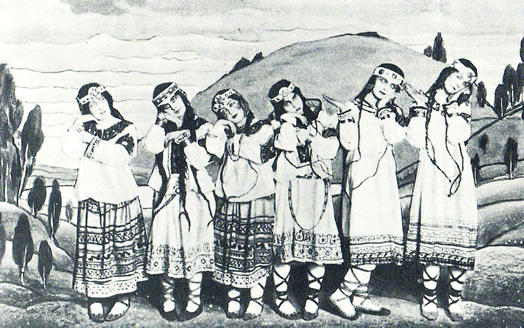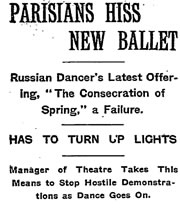Allegro
When music could cause riots
Reflections on "The Rite of Spring" at 100
Volume 113, No. 5May, 2013
This month is the 100th anniversary of the first performance of Stravinsky’s “The Rite of Spring,” which took place in 1913 in Paris. The reports of that initial performance are part of music lore and we now ask, with some incredulity: did people really riot on the street after the “Rite of Spring?” Was the event really a cause célèbre in wider Parisian society? Did it matter much? Apparently…it did! (Does a ballet, symphony, or opera matter so much today?)
But 1913 was the year immediately prior to World War I, perhaps the most stupidly wasteful war of all. (The comparatives here are not much better: few wars justify their costs.) And yet, despite the nearly sociopathic destruction of those war years, the art created just prior and just beyond the world’s physical and psychological destruction has persevered in spectacular form. The artists from that period – Stravinsky, Picasso and James Joyce, to name just a few – created radical and transformational works. These artists and others still project huge influences today.
I relate that very brief and inadequate cultural history only to say that any symphonic musician who sees the “Rite” on their performance schedule takes a deep breath and understands that their schedule has changed. That 100-year-old piece always requires renewed attention. Why?
Well, no matter how many times you have played the piece, you need to ask yourself many questions, at least including the following:
-
Do you know the time signatures? Can you count them…and feel them?
-
Does your conductor know the time signatures?
-
If you’re a string player, can you play like a machine, and then instantly leap to lyricism?
-
If you’re a wind player, can you perform the delicate, soloistic, and rhythmically complex opening? And then can you play like a machine? And get lyrical again?
-
If you’re a brass player, can you play the notes – high notes, very loud, with no preparation – and can you then play every other note on your horn? Short and loud, long and sustained? If so, can you trust your conductor to know the difference?
-
And…hi there, percussionists! You all drive the boat. When you are on, everyone else is confident. But are you on?
Most of all, assuming all of those elements are more or less in place, the “Rite” is an intense on-stage experience. The rhythmic intensity and the sheer volume and profound presence of the full forces of a symphony orchestra make for an experience that is utterly overwhelming for a performer.
But the “Rite” was originally conceived as ballet. The huge forces are somewhat reduced for ballet pit performances due to space and numbers, and thus logistics. When done as ballet, a musician’s performing experience is, if anything, more intense. Why? Because the orchestra pit, and the ballet’s budget, can’t fit the entire “Rite” orchestra as conceived by Stravinsky.
So, for me, a few memories.
The very first time I performed the “Rite” was with the Yale Symphony Orchestra in the mid-1970s. Prior to the first rehearsal I went to the music library and learned, sort of, how to conduct it. That’s the only way I got through it.
I also remember a performance at the Northeast Pennsylvania Philharmonic in Scranton, when the resident maestro added a beat somewhere in Part 2, and, with some trepidation and instantaneous adjustment, our trombone section saved the day by somehow doing an instantaneous addition and subtraction of observable beats and therefore got everyone on track. (Afterward, the maestro said to us, “Thanks, gentlemen! But you did not follow!” Go figure.)
More memorably, more than 20 years ago, I performed a re-orchestrated version by Robert Rudolf with the Joffrey Ballet, when the company still had a New York presence. At the Joffrey, we performed a program consisting of Satie’s “Parade” and Stravinsky’s “Petrushka” and “Rite of Spring.” Twice a day on some weekends…with an orchestra of 47! We were inspired by that music. We soldiered on in joy and wowed the audience. We were proud and inspired to create that music. We worked very, very hard. Oh, and, due to our union contracts, we were well paid.
Once, a conductor actually apologized for making a mistake and leading us all astray for a moment. We got him back on track. We all knew the piece!
I remember how the Westchester Philharmonic under Paul Dunkel nailed a performance of the “Rite” in performance after only three rehearsals. New York musicians are the best!
The American Ballet Theatre retains the “Rite” in its repertoire, although it has been at least 10 years since a performance. Let’s all hope that production can return to the stage.
The “Rite” remains always an event and a challenge to performers and to audiences alike. The experience of playing it defines our art and our profession.
I ask now whether our ballet companies, our audiences, and our local orchestras have the will to support and re-create this piece, which amazingly remains the seminal piece of both our last century and the current century! That support requires vision and the funding to support the forces that make the “Rite of Spring” so memorable and transformative for all who experience it. I surely hope that vision endures, having received and shared that gift myself. Without that vision, we are all diminished.
Trombonist Tom Olcott is the financial vice president of Local 802, and the supervisor of the union’s concert department.



